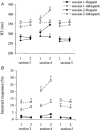Motor fatigue and cognitive task performance in humans
- PMID: 12433971
- PMCID: PMC2290666
- DOI: 10.1113/jphysiol.2002.027938
Motor fatigue and cognitive task performance in humans
Abstract
During fatiguing submaximal contractions a constant force production can be obtained at the cost of an increasing central command intensity. Little is known about the interaction between the underlying central mechanisms driving motor behaviour and cognitive functions. To address this issue, subjects performed four tasks: an auditory choice reaction task (CRT), a CRT simultaneously with a fatiguing or a non-fatiguing submaximal muscle contraction task, and a fatiguing submaximal contraction task alone. Results showed that performance in the single-CRT condition was relatively stable. However, in the fatiguing dual-task condition, performance levels in the cognitive CRT deteriorated drastically with time-on-task. Moreover, in the fatiguing dual-task condition the rise in force variability was significantly larger than during the fatiguing submaximal contraction alone. Thus, our results indicate a mutual interaction between cognitive functions and the central mechanisms driving motor behaviour during fatigue. The precise nature of this interference, and at what level this interaction takes place is still unknown.
Figures




References
-
- Bigland-Ritchie B, Rice CL, Garland SJ, Walsh ML. Task-dependent factors in fatigue of human voluntary contractions. In: Gandevia SC, Enoka RM, McComas AJ, Stuart DG, Thomas CK, editors. Fatigue. New York: Plenum; 1995. pp. 361–380. - PubMed
-
- Dettmers C, Fink GR, Lemon RN, Stephan KM, Passingham R, Silbersweig D, Holmes A, Ridding MC, Brooks D, Frackowiak RSJ. The relation between cerebral activity and force in the motor areas of the human brain. Journal of Neurophysiology. 1995;74:802–815. - PubMed
-
- Dettmers C, Lemon RN, Stephan KM, Fink GR, Frackowiak RSJ. Cerebral activation during the exertion of sustained static force in man. NeuroReport. 1996;7:2103–2110. - PubMed
-
- Dimitrijevic MR, McKay WB, Sarjanovic I, Sherwood AM, Svirtlih L, VrbovÀ G. Co-activation of ipsi- and contralateral muscle groups during contraction of ankle dorsiflexors. Journal of the Neurological Sciences. 1992;109:49–55. - PubMed
-
- Freeman GL. The facilitative and inhibitory effects of muscular tension upon performance. American Journal of Psychology. 1933;45:17–52.
MeSH terms
LinkOut - more resources
Full Text Sources
Research Materials

